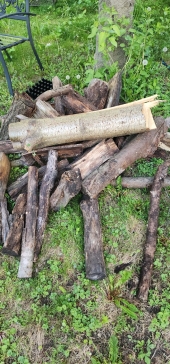





Permaculturist, Herbalist, Acupuncturist




 4
4








Freakin' hippies and Squares, since 1986




 1
1








Please check me out. http://www.dandeliondreamspermaculture.com
http://www.dandeliondreamsfarm.com




Nicholas Mason wrote: But I dont get the point of why you want to put it under the hugel bed, and over it. sounds like a lot of pointless work. And if you are putting the newspaper over the logs before dirt I would think that you would be losing part of the glory of the hugel bed by keeping the dirt from interacting with the logs and helping to build that hugel net.
Freakin' hippies and Squares, since 1986
 1
1




Jay C. White Cloud wrote:
I am also sorry Matu, but Paul is correct in his worry about "toxic gick," just because you can't find science or evidence for it's precedence does not mean it is not there.
Jay C. White Cloud wrote:I can't tell you how many grocery warehouses I have seen with boxes piled to the ceiling on pallets sprayed down with some of the most toxic pesticides you could imagine. Some in the same family as DDT. I even heard a woman say during a gardening presentation that cardboard is, "safe enough to eat." Not only would I not eat it, I would not even touch some of it without gloves.




Rich Conley wrote:Just because you're afraid it might be there, doesn't mean it is.
Rich Conley wrote:I spent a couple years working in a grocery warehouse, and have never seen, nor even heard anything like this.




I use cardboard over mine because right now the hugel (umlauts?) is just a pile of mushroom logs and I am trying to keep them both shaded and moist which any mulch (be it cardboard or otherwise) will help with. If it survives the winter (I have lots of mushrooms around that are attacking it as I type) I'll use it as mulch over the soil I put down in spring.
Cardboard (when not laden with toxic gick - which the manufacturing and resource extraction process no doubt is) seems like it would easily digest and incorporate into the soil matrix to me - becoming part of the net
I think the point of using it under logs would be as a (fairly effective) weed suppressor if you don't want to dig. Though doubtlessly digging in at least some of your logs will help with the decomposie goodness
Please check me out. http://www.dandeliondreamspermaculture.com
http://www.dandeliondreamsfarm.com














Please check me out. http://www.dandeliondreamspermaculture.com
http://www.dandeliondreamsfarm.com




Freakin' hippies and Squares, since 1986










 1
1




Just because you're afraid it might be there, doesn't mean it is.
 2
2





 3
3




Order copies of my book, Dairy Farming: The Beautiful Way at
www.createspace.com
Help spread the word! Thanks!
struggle - hustle - soul - desire















Matu Collins wrote:I'm not freaking out about bindweed (anymore) but I take it seriously. I have limited hands-on garden time and it takes a lot of hands to grow anything but....
Matu Collins wrote:I'm not worried about capillary action.














Please check me out. http://www.dandeliondreamspermaculture.com
http://www.dandeliondreamsfarm.com





Nicholas Mason wrote:I would like to know more about what you actually did to lower your bind weed problem Adam; maybe Adam has awesome secrets that he could share.
Order copies of my book, Dairy Farming: The Beautiful Way at
www.createspace.com
Help spread the word! Thanks!
struggle - hustle - soul - desire




It's time to get positive about negative thinking  -Art Donnelly
-Art Donnelly




Let the bindweed get big and start to flower, then pull it by hand and leave it on top of the soil surface. If you pull it too small, it doesnt deplete the plant's root reserves enough. Flowering is the best time to get it.
Please check me out. http://www.dandeliondreamspermaculture.com
http://www.dandeliondreamsfarm.com


















Joe's Garden Journal Blog
wholeviewfarm.blogspot.com



















Order copies of my book, Dairy Farming: The Beautiful Way at
www.createspace.com
Help spread the word! Thanks!
struggle - hustle - soul - desire














 You guys are awesome. I've learned a lot from this.
You guys are awesome. I've learned a lot from this.
Permaculturist, Herbalist, Acupuncturist

|
All of the world's problems can be solved in a garden - Geoff Lawton. Tiny ad:
Homestead Pastured Poultry course
https://permies.com/wiki/364740/Homestead-Pastured-Poultry
|






